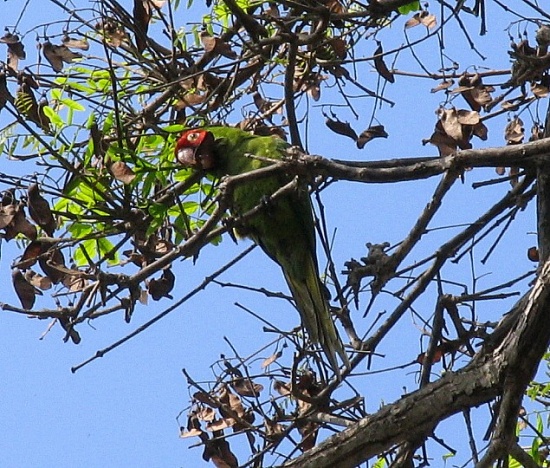(genus change (Clements and IOC)) |
m |
||
| Line 18: | Line 18: | ||
*''P. m. chlorogenys'' | *''P. m. chlorogenys'' | ||
*''P. m. tucumanus'' | *''P. m. tucumanus'' | ||
| − | *''P. m. | + | *''P. m. alticola'' |
A fifth subspecies ''hockingi'' has been proposed, and both this one and ''alticola'' have been proposed as full species (usually occurring at higher elevation than other Mitred Parakeets), currently without much support<sup>[[#References|[2]]]</sup>. <br /> | A fifth subspecies ''hockingi'' has been proposed, and both this one and ''alticola'' have been proposed as full species (usually occurring at higher elevation than other Mitred Parakeets), currently without much support<sup>[[#References|[2]]]</sup>. <br /> | ||
Revision as of 18:26, 23 August 2014
- Psittacara mitratus
Includes: Chapman's Parakeet and Hocking's Parakeet
Identification
Green, red forehead grading into scattered bright red feathers on crown, face, cheek, and sometimes on the bend in the wing and on the thighs. Dull green underparts are faintly washed olive. Sexes similar. Juvenile shows less red and has a brown rather than orange iris.
Variation
Subspecies mitratus has a good deal of red, while alticolus (higher elevation in same area) lacks red on thighs and have reduced red in face.
Distribution
Introduced to for example Hawai'i, Miami (where several hundreds are found), and Los Angeles (numbers in hundreds to thousands)
Taxonomy
Four subspecies are recognized[1]:
- P. m. mitratus
- P. m. chlorogenys
- P. m. tucumanus
- P. m. alticola
A fifth subspecies hockingi has been proposed, and both this one and alticola have been proposed as full species (usually occurring at higher elevation than other Mitred Parakeets), currently without much support[2].
Formery placed in genus Aratinga.
Habitat
Dry subtropical forest, and rocky cliffs.
Behaviour
Calls are loud, raucous, and are given both when sitting and when flying.
References
- Clements, JF. 2009. The Clements Checklist of Birds of the World. 6th ed., with updates to December 2009. Ithaca: Cornell Univ. Press. ISBN 978-0801445019.
- Birdforum thread discussing Mitred Parakeet and potential splits
- National Geographic Society. 2011. Field Guide to the Birds of North America, 6th edition. Washington DC: National Geographic Society. ISBN 978-1-4262-0828-7
Recommended Citation
- BirdForum Opus contributors. (2024) Mitred Parakeet. In: BirdForum, the forum for wild birds and birding. Retrieved 25 April 2024 from https://www.birdforum.net/opus/Mitred_Parakeet





